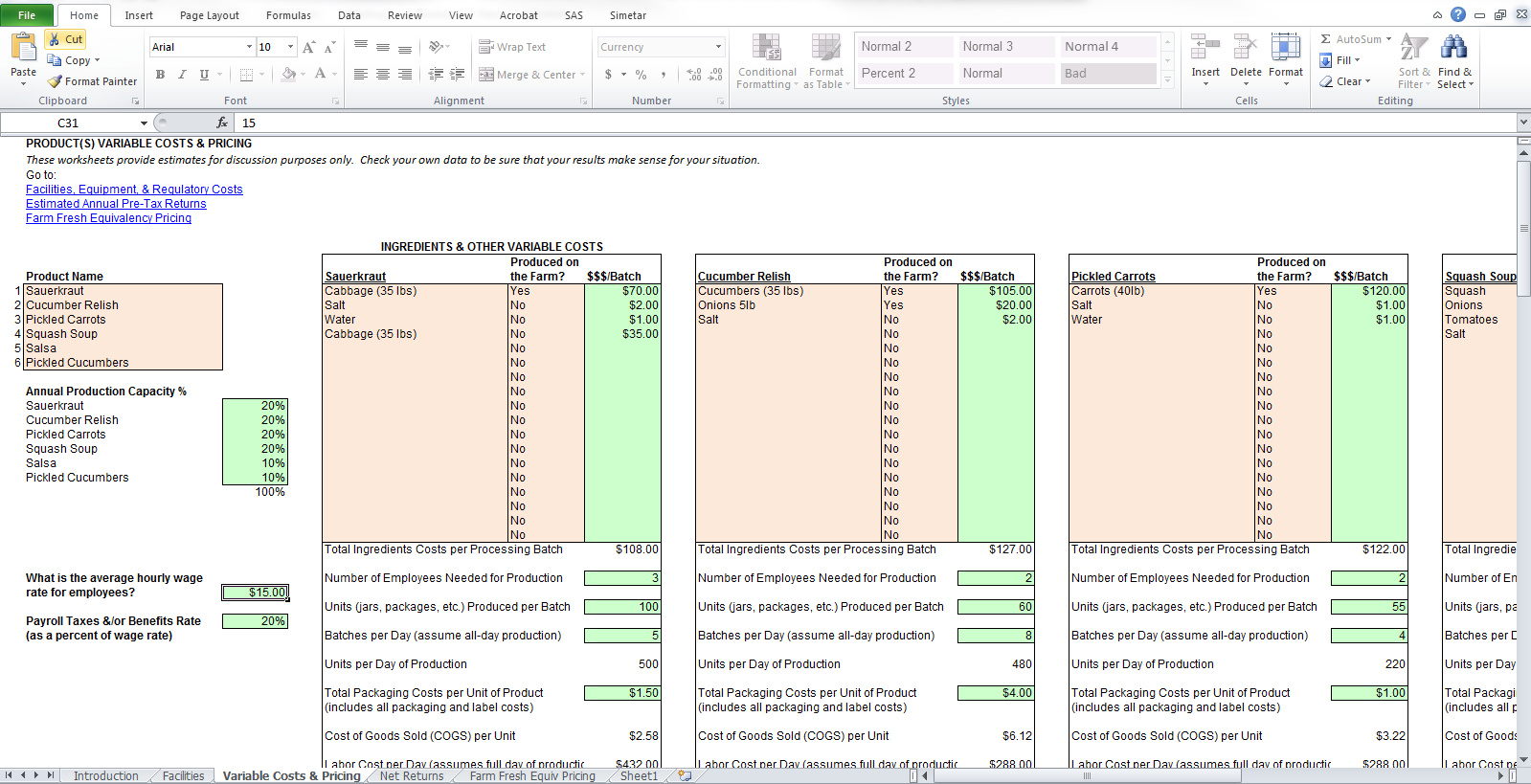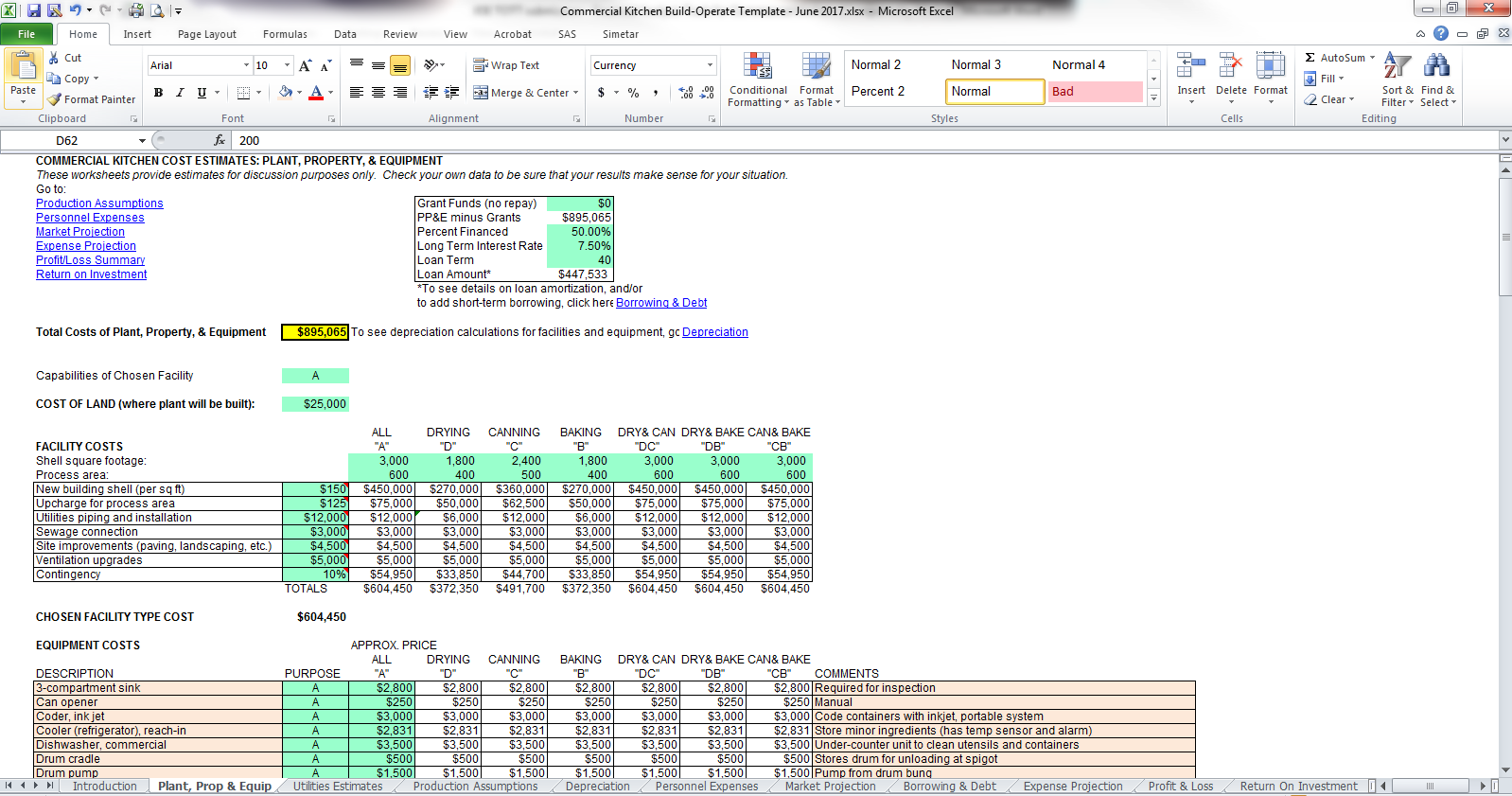 |
April 2018
|
April 2018 // Volume 56 // Number 2 // Tools of the Trade // v56-2tt3
Financial Analysis Tools for On-Farm and Off-Farm Commercial Kitchens
Abstract
This article describes two spreadsheet-based tools designed to help farmers evaluate the viability of building and operating commercial kitchens, on-farm and off-farm, to meet the demand for locally processed foods. Both tools let users define the processing activities and kitchen capacity, including the appropriate equipment, personnel needs, days of operation, and processed products. The on-farm kitchen model provides annual return estimates, allowing users to change recipes each year to match changes in annual farm production. The off-farm kitchen model assumes a stand-alone facility with depreciation schedules, loan amortization schedules, 10-year profit/loss projections, and various measures of return on investment.
Introduction
The local food movement has spurred interest in local food processing by producers wishing to extend their marketing opportunities and make use of unsold fresh produce. Extension has made great strides in programs and online assistance for small-farm operators and local food market assessment (e.g., Hostetler, 2007; Marshall, Bush, & Hayes, 2005; Raison, 2010; Sharp, Clark, & Davis, 2011); however, the availability of programs and online software tools for those starting/operating local food processing ventures is relatively limited.
The Robert M. Kerr Food & Agricultural Products Center (FAPC) at Oklahoma State University has received multiple requests for technical and financial assessment of proposed facilities: on-farm kitchens, incubator kitchens, licensed kitchens at farmers' markets, and larger-scale food processing establishments. Stemming from these requests, the FAPC has developed two planning tools that help food business start-ups assess options for commercial kitchens. "Commercial" kitchens meet all regulatory requirements to manufacture products destined for retail and food service markets. Similar to the template for small-meat-plant feasibility described by Holcomb, Flynn, and Kenkel (2012), these planning tools allow users to define the structural and operational parameters of the business and examine the impacts of changes to any one of these parameters.
Several examples of commercial kitchen layouts and suggested equipment lists can be found online, with sources varying from equipment suppliers to Pinterest pages. However, none of these sources provides a reader with tools for developing a customized operating scenario or performing a "what if" analysis. The On-Farm Kitchen Financial Analysis Model (on-farm model) and the Financial Analysis Model for Building/Operating a Commercial Kitchen (larger-scale model) allow users to incorporate aspects of various layouts and equipment suggestions as a starting point for a detailed financial assessment.
Features
These spreadsheet-based models and their embedded user's guides help producers and local food entrepreneurs develop a financial model for a customized on-farm or off-farm commercial kitchen. The on-farm version is intended for producers who wish to build or repurpose space on their farms to process their own farms' production outputs, adhering to either commercial processing regulations or cottage food industry regulations. The larger-scale model is designed for users (farmers or not) who wish to build, equip, and operate an inspected commercial food processing facility. Information and insights provided by FAPC food processing engineers and food scientists, plus facility layouts and equipment lists from FAPC-assisted commercial kitchens, were used for generating the example construction costs and equipment lists/prices currently in the models.
Users provide information in green- and tan-shaded cells in each model, with the tan-shaded cells mostly being for notes related to equipment specifications, assumptions, and recipes. Some input cells involve drop-down menus for type of processing/purpose of equipment—canning, dehydration/drying, baking, combinations of any two of these processing activities, or all three processing activities. Both models have tabs where production data such as product/category names, percentage of production capacity devoted to each product/category, and ingredients and variable costs per batch are entered. For the on-farm kitchen model, users also identify ingredients as "on-farm" or "off-farm," and an imputed fresh value of all on-farm ingredients per batch is calculated.
For promoting ease of use, hyperlinks and pop-up comments were incorporated in the templates. For example, users of the larger-scale model can hyperlink between the "Plant, Property, and Equipment" input area and the loan amortization and depreciation schedules to see impacts of changes in capital expenditures. Similarly, some cells include pop-up comments to help users better understand the requested inputs. Additionally, password protection prevents users from inadvertently altering cell formulas.
The on-farm model is designed to calculate annual (seasonal) and daily fixed costs from user input, so users can see the impacts of changes in processing days or hours per day. Because a small farm's production may change drastically from year to year, the on-farm model is designed to emphasize one year's returns from processing. Producers can modify the model each year to match the crops grown and processed that year.
The larger-scale model assumes a larger, stand-alone business that can meet all state and federal food processing requirements. This model has more product category options, allowing a user to consider both own-product processing and copacking for others. Unlike the on-farm model, the larger-scale model emphasizes 10-year projections based on user-provided information.
Figure 1 shows the "Product(s) Variable Costs & Pricing" section of the on-farm kitchen model. Producers can calculate the costs per batch for each intended product, batches per day, packaging costs, and labor requirements. Not shown in Figure 1 is a text box for each product where users can input notes or processing steps.
Figure 1.
Product Descriptions, Variable Costs, and Pricing Inputs Section for the On-Farm Kitchen Model

Figure 2 shows the "Plant, Property, & Equipment" portion of the larger-scale model. Users identify the size and processing capabilities of the facility, costs for land and construction, types and costs of equipment, and debt financing assumptions. Debt repayment and depreciation schedules are calculated on the basis of user input. Construction costs in the base model are from actual construction quotes, and equipment costs are mostly quotes from commercial kitchen equipment suppliers. These should be adjusted to match the user's expectations.
Figure 2.
Plant, Property, and Equipment Input Area for the Larger-Scale Kitchen Model

Both models also have input areas for additional information related to production and nonproduction labor, marketing and regulatory expenses, and supplies/miscellaneous expenses.
The on-farm model calculates an annual pretax return from processing that can be either included in the farm's annual profit/loss or treated as a separate business activity. The larger-scale model has a "Return On Investment" section that calculates net present value, internal rate of return, return on assets, return on beginning owners' equity, and payback period. All profitability and returns measures automatically update with a change in any user-defined cell, allowing for easy sensitivity analyses.
Summary
Extension educators can use the On-Farm Kitchen Financial Analysis Model and the Financial Analysis Model for Building/Operating a Commercial Kitchen to help agricultural producers and local food entrepreneurs determine the feasibility of adding processing to their local food marketing efforts. Both templates can be downloaded from http://fapc.biz/services-and-disciplines/files.
References
Holcomb, R. B., Flynn, K., & Kenkel, P. (2012). A feasibility template for small, multi-species meat processing plants. Journal of Extension, 50(5), Article 5TOT11. Available at: http://www.joe.org/joe/2012october/tt11.php
Hostetler, K. M. (2007). Answering the producers' question: Is it feasible? Journal of Extension, 45(6), Article 6FEA5. Available at: http://www.joe.org/joe/2007december/a5.php
Marshall, M. I., Bush, D., & Hayes, K. (2005). Extension programming for food entrepreneurs: An Indiana needs assessment. Journal of Extension, 43(5), Article 5RIB9. Available at: http://www.joe.org/joe/2005october/rb9.php
Raison, B. (2010). Educators or facilitators? Clarifying Extension's role in the emerging local food systems movement. Journal of Extension, 48(3), Article 3COM1. Available at: http://www.joe.org/joe/2010june/comm1.php
Sharp, J. S., Clark, J. K., & Davis, G. A. (2011). Adapting community and economic development tools to the study of local foods: The case of Knox County, Ohio. Journal of Extension, 49(2), Article 2FEA4. Available at: http://www.joe.org/joe/2011april/a4.php




